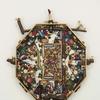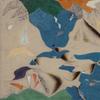GETTY RESEARCH INSTITUTE ACQUIRES ARCHIVE OF THE HISTORIC KNOEDLER & COMPANY GALLERY
- LOS ANGELES, California
- /
- October 18, 2012
The Getty Research Institute (GRI) announced today the acquisition of the archive of the historic Knoedler & Company Gallery, the premier American art gallery from the mid-19th century through the 20th century. Dating from circa 1850 to 1971, the comprehensive archive is a vast trove of diverse original research materials including letters, telegrams, albums, sales books, stock and consignment books, card files on clients and art works, rare photographs, reference photo archives, and rare books.
“This tremendous archive represents a vital chapter in both American and European art history and is an invaluable American cultural resource,” said Thomas Gaehtgens, director of the Getty Research Institute. “We look forward to the exceptional research, publications and exhibitions that will no doubt arise from the Getty Research Institute’s ability to make this material available to our own scholars and researchers from around the world. We are already planning a research project which will reconsider the history of the transfer of European art to the US based on this outstanding trove.”
The meticulously kept archive provides a complete history of how the Knoedler Gallery created a foothold in New York, bridging the well-established business of art in Europe with the burgeoning art market in the U.S., while consistently advocating and promoting American artists. From its start in the mid 1800s through the changing tides of taste into the late 20th century, the Knoedler Gallery was consistently a prestigious and influential player in the American art market. The Knoedler Gallery closed in 2011, after 165 continuous years in operation.
“For nearly thirty years, the Getty Research Institute has selectively acquired major archival collections of galleries and dealers that chronicle the history of European and American taste in the 19th and 20th centuries,” said Marcia Reed, chief curator at the Getty Research Institute. “Combined with the resources of our Project for the Study of the History of Collecting and Provenance, these archives in the GRI’s Special Collections make the GRI a premier international center for research on the art market, provenance, and the history of collecting.”
In 1847, the rapidly growing Parisian print publisher Goupil, Vibert & Cie, sent an agent to New York to establish an office catering to what was then seen as the untapped and potentially huge market for art in America. In 1848, William Schaus opened the Goupil branch downtown at 289 Broadway, near City Hall. Initially the firm successfully sold reproductive prints made in Paris, making a profit and injecting French aesthetics into the American art scene, with clients all over the East Coast and as far west as the Mississippi River. The gallery also astutely identified appealing original works of art by American artists for reproduction in Paris, reintroducing them to the U.S. as affordable engravings and lithographs.
In 1857 the firm’s second New York manager, Michael Knoedler, who was trained by Adolphe Goupil in Paris, took the opportunity to buy out the New York branch. Knoedler’s persistent energy, backed by the powerful Maison Goupil (archives of which are already in the GRI’s collection), contributed to a shift in American taste and culture. The archive includes documentation of Knoedler’s interactions with movers and shakers of the early New York art world—people such as John Taylor Johnston, the first president of the Metropolitan Museum of Art; Robert L. Stuart, a major donor to the New York Public Library, and prominent collector Catharine Lorillard Wolfe.
The Knoedler Gallery continued to thrive and shifted focus from French Salon paintings toward Old Masters and British Art. By the 1880s the gallery had competition in New York but was still far and away the major supplier of art to the American market—the peak years being 1905–1930. Clients included notable names such as Henry Clay Frick, Andrew Mellon, Robert Sterling Clark, Estelle Doheny, and the Huntington family. In 1930–31 this tidal wave of trade was punctuated by the landmark sale of masterworks from the collection of the State Hermitage Museum in Leningrad to Andrew Mellon.
Knoedler’s success continued into the mid-20th century, when in addition to Old Masters, the gallery developed a contemporary art division selling works by Louise Bourgeois, Salvador Dalí, Willem de Kooning, Arshile Gorky, Eva Hesse, Henry Moore, Barnett Newman, Tony Smith, and many others.
Housed for decades in the gallery’s New York office, this essential archive on art, artists, collectors, museums and vicissitudes of style and taste has never been widely accessible for research. The collection is particularly significant for the light it sheds on the business side of art dealing: it tells the story of how works of art moved back and forth among Knoedler, other dealers, and collectors whose names represent the crème de la crème of American society.
Especially notable in the Knoedler Archive is the considerable number of letters from 19th and 20th century artists, collectors, and others. The archive includes hundreds of letters written by the likes of Alexander Archipenko, Léon Bakst, Sarah Bernhardt, Rosa Bonheur, Alexander Calder, Edgar Degas, Max Ernst, Naum Gabo, Greta Garbo, Paul Gauguin, Childe Hassam, Winslow Homer, Rockwell Kent, Henri Matisse, Irving Penn, Mark Rothko, Augustus Saint-Gaudens, John Singer Sargent, John Sloan, Joseph Stella, Edward Steichen, Louis Comfort Tiffany, and William Zorach. Many of these letters are illustrated. From Homer, for example, there are 14 letters with drawings.
Founded before most museums in the U.S., the Knoedler Gallery factored significantly into the development of many American private collections, in turn influencing the collections of America’s important public museums. The J. Paul Getty Museum owns more than a dozen paintings and drawings that were either brought to the U.S. via the Knoedler Gallery, or sold by Knoedler at one point. Indeed the Getty Museum’s iconic Irises (Vincent van Gogh, 1889) and Portrait of Madame Brunet (Édouard Manet, about 1860–1863, reworked by 1867) were both acquired by the prominent New York-based collector Joan Whitney Payson from the Knoedler Gallery.
The massive archive must be cataloged, processed, and conserved by experts at the GRI but it will eventually be made available to researchers on site and digitized for online research. It joins other gallery archives at the GRI including records for the Goupil & Cie and Boussod Valadon galleries, the parent organization of Knoedler, and the Duveen Brothers records.






__2016_100x100_c.jpg)




![Peter Paul Rubens (Flemish, 1577–1640), After Titian (Tiziano Vecelli) (Italian [Venetian], c. 1488–1576), Rape of Europa, 1628–29. Oil on canvas, 71 7/8 x 79 3/8 in. Peter Paul Rubens (Flemish, 1577–1640), After Titian (Tiziano Vecelli) (Italian [Venetian], c. 1488–1576), Rape of Europa, 1628–29. Oil on canvas, 71 7/8 x 79 3/8 in.](/images/c/e2/2e/Jan20_Rape_of_Europa100x100_c.jpg)




